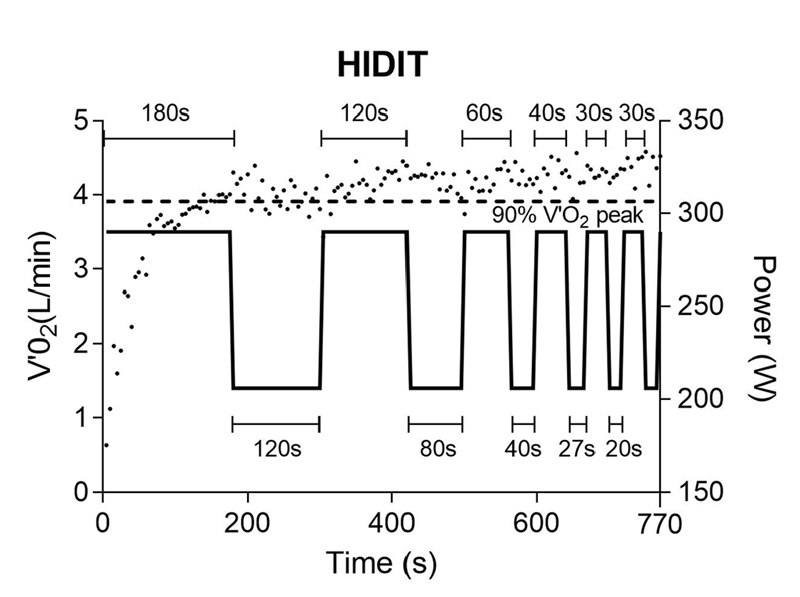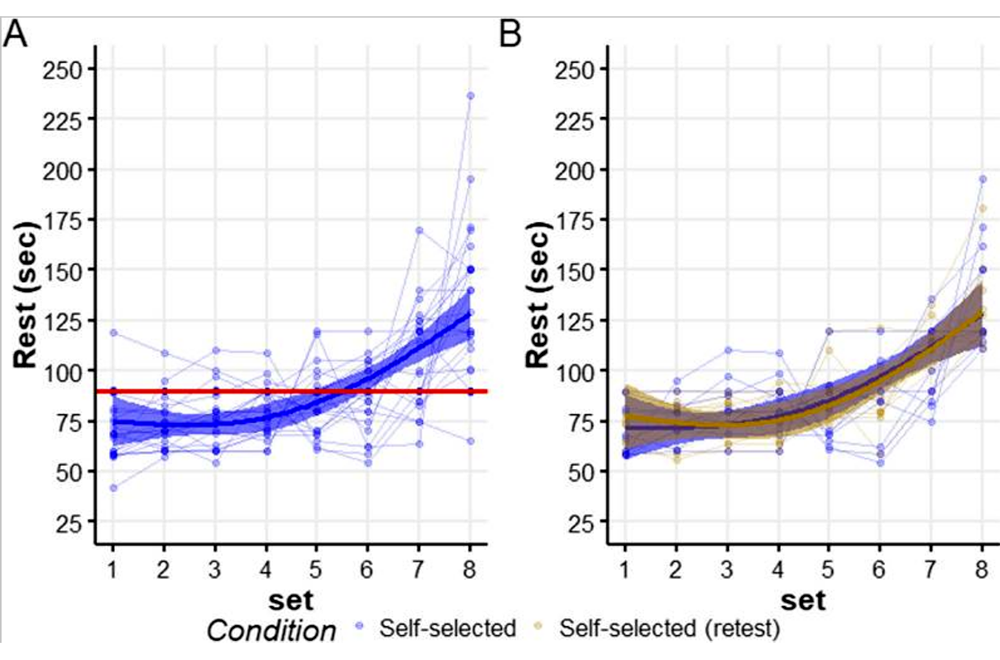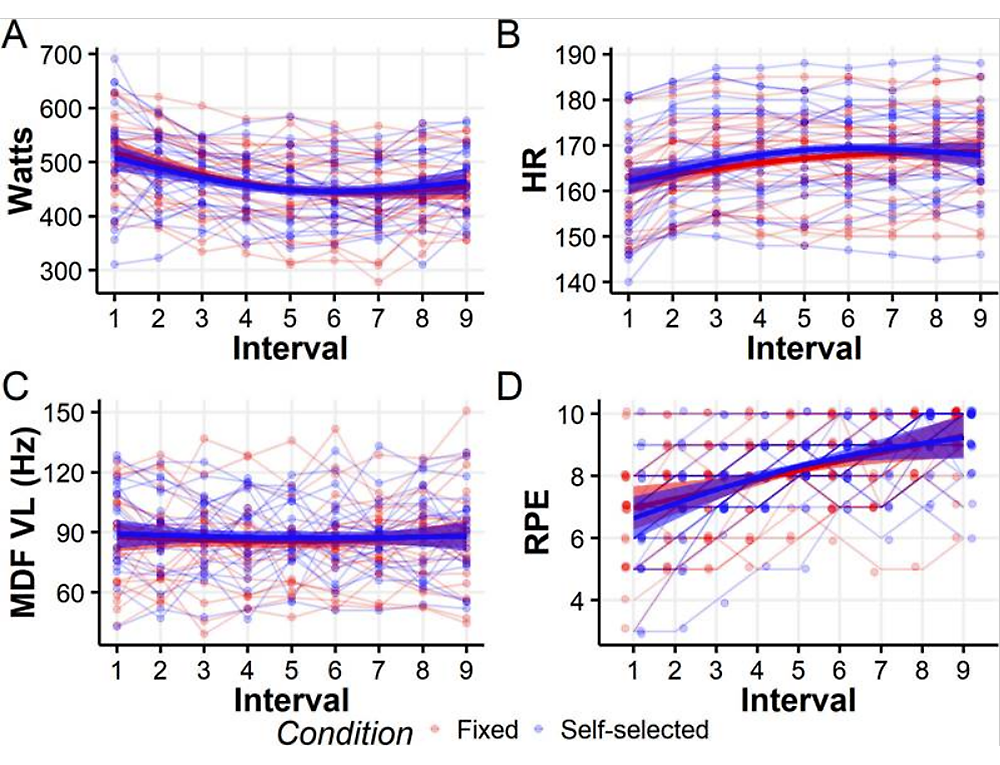You are viewing 1 of your 1 free articles. For unlimited access take a risk-free trial
High-intensity intervals: Should I stay or should I go?
Should you used a fixed approach to rest length when performing interval training, or is there a better way? SPB looks at some brand new research
As regular readers will be aware, research over the past 25 years has seen a large body of evidence accumulate that regular sessions of high-intensity interval training (HIIT) can produce significant fitness gains in less time and with less effort than a higher volume of steady-state endurance training(1-4). Moreover, these benefits are not just limited to elite athletes; recreational athletes who introduce intervals to a training schedule actually stand to gain even more than more advanced level athletes (who will almost certainly already be utilizing interval training in their training programs)(5).
Putting together the ideal interval session
Scientists have determined that there are six major factors determining the overall ‘recipe’ for productive interval training(6,7). These are:
· Total workload of a session
· Duration of each interval
· Interval intensity
· Recovery (rest) duration
· Recovery type (ie active or passive)
· Total interval training time per week
Depending on the purpose of the interval session, these variables can be manipulated to give countless different combinations of interval workouts. Of these variables, the interval intensity, its length, and the number of intervals performed per session have received copious attention from scientists. There is also a fair body of research on the rest periods between intervals, principally the length of the rest period and whether that rest is active (ie consisting of light activity) or passive (where the athlete simply stops completely) in nature – see this article for a more in-depth discussion.
Variable and dynamic interval sessions
With so many variables to manipulate, it’s little wonder that most studies into interval sessions and how to make them more productive have been carried out used fixed rather than dynamic parameters. So for example, studies on high-intensity intervals have almost always employed sessions where athletes complete a set of intervals at a fixed and pre-determined workload (power, speed, % of maximum power etc) in each and every interval in that session. Likewise, the rest intervals in these studies are almost always fixed and pre-determined – ie a fixed length of time for every rest period and always of the same type (passive or active).
In a 2020 article published to the SPB online library, we looked at the groundbreaking research into the use of dynamic interval efforts for maximizing the benefits of high-intensity cycling intervals – specifically, the use of diminishing interval lengths as the session progresses(8). In a nutshell, this study compared a dynamic interval session consisting of ‘high-intensity decreasing intervals’ (work interval lengths starting at 3 minutes duration decreasing to 30 seconds, and recovery starting at 2 minutes reducing to 20 seconds – see figure 1) with a static interval session (one providing exactly the same amount of total workload, and the same ratio of work to recovery but with constant interval lengths and recovery lengths.
The results clearly showed that it was the dynamic decreasing interval session that enabled the cyclists to maintain a greater total of time above 90% VO2max (the threshold above which training is deemed to be most effective for boosting endurance). In the dynamic protocol, the cyclists accumulated an average of 312 seconds above 90% VO2max compared to 182 and 179 seconds in the short and long HIIT protocols respectively. In addition, the dynamic protocol also enabled the cyclists to accumulate more total work above critical power.
Figure 1: Dynamic (reducing) interval length/recovery session

Dynamic rest intervals
As we said above, the rest duration during interval sessions is traditionally prescribed using a fixed approach, in which athletes are prescribed active or passive rest periods of predetermined durations. Typically, the work-to-rest ratios ranging from 1:0.5 (eg 60 seconds effort interspersed with 30 seconds rest) to 1:20 (eg 15 seconds flat out interspersed with 5-minute rests)(9).
But while a fixed approach to rest periods is a proven and effective method, there are shortcomings. Firstly, different athletes may respond very differently to the prescribed rest period. Secondly, some athletes prefer to vary rest periods – for example resting for shorter durations between the first few intervals and using longer rest durations as the session progresses. Having this sense of control during training is known to lead to positive psychological effects(10). Thirdly, fixed rest duration does little to challenge and hone athletes’ decision-making processes. This contrasts with what is actually required during endurance events, where athletes are required to strategically increase, decrease, or maintain speed as a function of the distance left to the finish line and/or their location relative to other competitors(11).
An alternative approach for setting the rest periods during interval sessions is by using a self-selected and dynamic approach, in which athletes choose the rest duration. In theory, this variable and dynamic approach – where athletes choose the rest duration based on their current and anticipated performance – has several advantages:
· It can accommodate individual differences and responses to a session of intervals.
· The act of choosing rest duration can enhance the enjoyment of and motivation to complete an interval session.
· A more dynamic approach can challenge and improve athletes’ decision-making processes in competitions, by having them practice when and how to use their rest periods in training.
Theory vs. reality
That’s the theory of variable rest, but does a more dynamic and flexible approach to setting rest lengths during an interval session actually work? It turns out that there’s very little data on using variable and/or self selected rest periods during interval session topic. Moreover, in those studies that have been carried out where athletes were given choice over their rest durations, the results were very mixed indeed(12-15).
Some of these ‘self-selected vs. fixed rest duration studies resulted in subjects choosing shorter or longer rest durations compared to the pre-prescribed fixed rest duration conditions. Moreover, the performance outcomes measured (eg total distance accumulated or average speed) varied between studies, resulting in both better and worse outcomes in the self-selected rest periods compared to fixed rest periods depending on which study you look at. To complicate matters further, the interval protocols used varied hugely in both the fixed interval and rest lengths, and numbers of intervals performed.
However, perhaps the biggest flaw of all in these studies comparing a fixed rest period to a self-selected one is that the total rest duration taken in the interval session as a whole was not matched. In other words, when comparing the fixed vs. variable (self-chosen) rest lengths, when the subjects selected their rest durations, the total amount of rest taken across the variable session was not matched to the total rest taken in the fixed session.
Given the total rest duration in an interval session has a major impact on performance, physiological, and psychological outcomes, this explains why the outcomes in previous studies on this topic have been so mixed and inconclusive. Practically, not controlling for total amounts of rest in an interval session also makes little sense. Firstly, taking uncontrolled rest durations in a variable interval session allows athletes to select overly short or long rest durations, which can contradict the session’s goals. Secondly, it can also prevent coaches from planning the overall session duration, given that the selected rest duration can vary considerably, especially in team settings. Finally, when the rest duration is unconstrained, the athletes’ decision-making process in each interval has little bearing on future intervals – exactly what does NOT happen in a race situation!
New research
To get a definitive answer as to whether self-selected of fixed rest periods produce better interval training outcomes, what’s needed is a study comparing the two but with identical total rest durations. And now a brand new study by a team of Israeli and Canadian scientists, published last month has done exactly this (16). Published in the journal ‘Sports Medicine-Open’, this consisted of a randomized crossover study with 24 amateur male cyclists, measuring performance, physiological, and psychological outcomes in fixed-rest versus self-chosen rest interval sessions, while ensuring total rest durations were held constant in both conditions.
The cyclists recruited were all well trained, with a training background of riding 200km per week for at least a year. All the cyclists attended three laboratory sessions: a familiarization session, and two experimental sessions, between three and eight days apart. After the familiarization session, the cyclists were randomized into two groups:
· Fixed rest periods – nine x 30-second intervals on a cycling ergometer with fixed rest periods of 90 seconds in between intervals, totalling 720 seconds of active rest across the session.
· Variable, self-selected rest periods – the same nine x 30-second interval protocol, but where the cyclists selected how long they would rest between the nine intervals. However, the total rest duration was matched so that the cyclists had to use 720 seconds of active rest throughout the session (after the first and before the last interval) in any way they chose.
Importantly, the cyclists were informed that the goal in both conditions was to maximize the total amount of watts produced over these nine intervals (ie total work done), as opposed to maximizing the watts output in every single interval. Resting in both conditions consisted of active recovery of pedaling using a very gentle resistance of 50 watts. The relatively long rest durations (90 seconds) were chosen so that the cardiovascular strain resulting from the completed intervals would minimally interfere with the cyclists’ decision-making abilities when they performed the self-selected trial.
Being a crossover trial, the interval session was repeated a few days later with the groups swapped (ie those who had completed the fixed rest session first now switched to self selected and vice versa). In addition to measuring total work completed, the scientists also measured and compared the cyclists’ watts, heart rate, muscle activity of the knee flexors and extensors, ratings of perceived effort and fatigue, and perception of autonomy and enjoyment.
What they found
The results were very clear cut, but perhaps in an unexpected way. With the exception of the sense of control the cyclists had, which was higher in the SS condition, the performance outcomes in terms of total work completed, average heart rates, perception of effort and quadriceps muscle activation patterns were pretty much the same regardless of whether the rest periods were fixed or self chosen (see figure 2). When inspecting the rest duration distribution in the self-selected trial, the researchers found that cyclists selected to rest for shorter durations in the first five intervals, and for longer duration in the last three intervals, compared to the fixed condition. However, this did not impact the average power output over the nine intervals as a whole or total work accumulated. Moreover this pattern observed during the self selected trial was not a fluke; in a retest of a sub-group of ten cyclists, an identical pattern was observed in the self-selecting condition (see figure 3).
Figure 2: Comparison of outcomes in fixed vs. self-selected rest periods
Related Files
A = average watts sustained across the nine intervals. B = average heart rate across the intervals. C = quadriceps activity (vastus lateralis). D = perceived exertion. The thin lines represent individual outcomes of each cyclist, under the fixed (red) and self-selecting (blue) conditions. The thick red and blue lines represent the range of average outcomes.
Figure 3: Test and retest results for the self-selected rest period trials

Making practical use of these findings
What can endurance athletes and their coaches conclude from this groundbreaking research and how can it be applied in practice? The most obvious conclusion is that if your training program includes interval sessions, you can feel confident that using either fixed rest periods or self-selected periods of rest will deliver a similar training load – ie will be equally effective in terms of training benefit – so long as the total rest time is held constant. In terms of which to choose, that will depend on your personal preferences and what it is you are trying to improve or monitor.
For example, using fixed rest durations provides you with a degree of certainty regarding the session’s configuration, which can than allow you to focus on say power production or speed in each of your interval efforts, without the need to think about tactical decisions regarding how to pace the session. Also, if you want to monitor performance or changes in performance, fixed rest durations are much more suitable because they don’t introduce unnecessary variability.
By contrast, using selective rest durations provides you with a certain degree of flexibility regarding your session’s configuration, which can break up monotony and give you a sense of control over the session structure based on how you feel. For example, you may prefer and benefit from shorter rest durations in the first few intervals, and longer rest durations in the latter intervals - or maybe, the opposite is true. In addition, practicing intervals using a flexible approach to rest durations while ensuring your total rest duration is unchanged is an excellent strategy to develop your ability to adjust and hone pacing, which is extremely useful for competition situations.
When adapting a fixed interval session to self-selected rest periods, all you need to do is first of all, calculate the total rest time that would have been accrued in your fixed session. This is simply equal to the rest periods of the fixed session multiplied by (the number of intervals – 1). So for a session consisting of 8 x 90-second intervals with 2 minutes of rest in between each interval, the total rest accrued is 2 x (8-1) minutes = 14 minutes.
If you then set an extra stopwatch to count down from 14 minutes, hitting the start button each time you get to a rest period and stopping it as you set off for the next interval, you can see how much total rest time is remaining as you work your way through the session. By dividing that time by the number of intervals remaining, you know what the average time per rest will be for those remaining efforts. In the example above, anything over 2 minutes means that you are ‘ahead of the game’ and have more rest to play with as the session progresses. Less than 2 minutes means that you have already taken more than 2 minutes per rest period and you’re going to have to work harder to play catch up!
References
1. PLoS One. 2014 Apr 15;9(4):e95025
2. Eur J Sport Sci. 2016;16(3):344-9
3. J Sci Med Sport 2007; 10: 27–35
4. Am J Physiol Regul Integr Comp Physiol 2008; 294: R966–R974
5. Scand J Med Sci Sports 2010; 20 Suppl 2: 1–106.
6. Sports Med. 2002, 32, 53–73
7. J. Strength Cond. Res. 2007, 21, 188–192
8. European Journal of Applied Physiology 2020. Vol 120, p2397–2405
9. Int J Sports Physiol Perform. 2019;14(6):859–867
10. Trends Cogn Sci. 2010;14(10):457–463
11. Physiol Rep. 2018;6(21):1–13
12. J Sci Med Sport. 2019;22(4):462–466
13. Pediatr Exerc Sci. 2022;34(4):1–9
14. Eur J Sport Sci. 2018;18(8):1058–1067
15. Med Sci Sports Exerc. 2005;37(9):1601–1607
16. Sports Med Open. 2023 Jul 3;9(1):52. doi: 10.1186/s40798-023-00601-8
Newsletter Sign Up
Testimonials
Dr. Alexandra Fandetti-Robin, Back & Body Chiropractic
Elspeth Cowell MSCh DpodM SRCh HCPC reg
William Hunter, Nuffield Health
Newsletter Sign Up
Coaches Testimonials
Dr. Alexandra Fandetti-Robin, Back & Body Chiropractic
Elspeth Cowell MSCh DpodM SRCh HCPC reg
William Hunter, Nuffield Health
Keep up with latest sports science research and apply it to maximize performance
Today you have the chance to join a group of athletes, and sports coaches/trainers who all have something special in common...
They use the latest research to improve performance for themselves and their clients - both athletes and sports teams - with help from global specialists in the fields of sports science, sports medicine and sports psychology.
They do this by reading Sports Performance Bulletin, an easy-to-digest but serious-minded journal dedicated to high performance sports. SPB offers a wealth of information and insight into the latest research, in an easily-accessible and understood format, along with a wealth of practical recommendations.
*includes 3 coaching manuals
Get Inspired
All the latest techniques and approaches
Sports Performance Bulletin helps dedicated endurance athletes improve their performance. Sense-checking the latest sports science research, and sourcing evidence and case studies to support findings, Sports Performance Bulletin turns proven insights into easily digestible practical advice. Supporting athletes, coaches and professionals who wish to ensure their guidance and programmes are kept right up to date and based on credible science.











